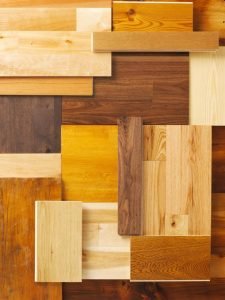The different types of wood flooring
 Wood floors come in a variety of styles to meet the demands of today’s busy lifestyles: factory finished, unfinished, solid, engineered, strip, plank, parquet and acrylic impregnated. Helping your customer choose the style that best suits their needs will be based on a variety of issues including lifestyle, decorating preference and location. Colors Wood floors come in a rainbow of colors to fit any décor. Unique, one-of-a-kind looks can be achieved with custom stains and finishes. Species Today’s wood floors come in more than 50 species—domestic and exotic—spanning the spectrum of colors, hardness and price ranges. Grades The appearance of the wood determines its grade. All grades are equally strong and serviceable, but each affords a different look.
Wood floors come in a variety of styles to meet the demands of today’s busy lifestyles: factory finished, unfinished, solid, engineered, strip, plank, parquet and acrylic impregnated. Helping your customer choose the style that best suits their needs will be based on a variety of issues including lifestyle, decorating preference and location. Colors Wood floors come in a rainbow of colors to fit any décor. Unique, one-of-a-kind looks can be achieved with custom stains and finishes. Species Today’s wood floors come in more than 50 species—domestic and exotic—spanning the spectrum of colors, hardness and price ranges. Grades The appearance of the wood determines its grade. All grades are equally strong and serviceable, but each affords a different look.
- Clear wood is free of defects, though it may have minor imperfections.
- Select wood is almost clear but contains some natural characteristics such as knots and color variations.
- Common wood (No. 1 and No. 2) has more natural characteristics such as knots and color variations than either clear or select grades and often is chosen because of these natural features and the character they bring to a room.
- No. 1 – Common has a variegated appearance, light and dark colors, knots, flags and wormholes.
- No. 2 – Common is rustic in appearance and emphasizes all wood characteristics of the species.
- First grade wood has the best appearance, natural color variations and limited marks. • Second grade wood is variegated in appearance with varying sound wood characteristics of species.
- Third grade wood is rustic in appearance allowing all characteristics of the species. Cuts The angle at which a board is cut determines how the finished product looks. Wood flooring is either plainsawn, quartersawn or riftsawn.
- Plainsawn is the most common cut. The board contains more variation than the other two cuts because grain patterns resulting from the growth rings are more obvious.
- Quartersawn produces less board feet per log than plainsawing and is therefore more expensive. Quartersawn wood twists and cups less and wears more evenly.
- Riftsawn is similar to quartersawing but the cut is made at a slightly different angle.